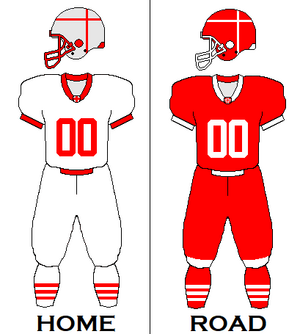Saint George Stadium: Difference between revisions
No edit summary |
No edit summary |
||
| Line 80: | Line 80: | ||
In the 2000s, [[Marvek Ottman]] sold the team to [[Utica Internationalis Holdings]], a [[Latium|Latin]] investment firm, which re-organised the club in-depth and injected in new cash. While at first this change led to more confusion and troubles, the Gyorgek were finally able to found their foot sport-wise and have returned to dominance since the 2010s. | In the 2000s, [[Marvek Ottman]] sold the team to [[Utica Internationalis Holdings]], a [[Latium|Latin]] investment firm, which re-organised the club in-depth and injected in new cash. While at first this change led to more confusion and troubles, the Gyorgek were finally able to found their foot sport-wise and have returned to dominance since the 2010s. | ||
==Structure== | |||
Saint-George Stadium is divided into four main sections: the International Section (which compete in the [[Belisarian Gridiron League]]), the National Section ([[National Division 1]]), the {{wp|Reserve team}} ([[National Division 3]]), and the Feminine Section. Both the National and Feminine sections have their own Youth team counterparts. Up until the 1990s, the International Section did not exist until 1993. Beforehand, the same team competed in both the Belisarian and National Leagues which led to schedule issues, administrative complications, and a greater risk of injuries for players. | |||
==Rivalries== | ==Rivalries== | ||
Revision as of 07:51, 26 December 2022
 | |
| Full name | Sent György Atlétikai Stadion |
|---|---|
| Nicknames | Györgyek Dragon Slayers |
| Short name | Saint-George |
| Based in | Angrast |
| Stadium | Saint George Stadium (building) |
| Owner | Utica Internationalis Holdings |
| Uniforms | |
 | |
The Saint George Stadium is a Drevstranese professional Gridiron football team based in Angrast' metropolitan area. The club has existed, in one form or another, since the 1910s and is considered one of the most iconic sport team in Drevstran and one of the greatest Gridiron franchise. At home, they compete in the National Division 1, the highest league of professional Gridiron in Drevstran, but they are also founding members of the Belisarian Gridiron League. The franchise also include a feminine, a junior, and an amateur section.
History
During the Drevstranese Civil War, Ottonian volunteers brought with them Gridiron football which quickly became popular among the units alongside which they served. Stranded in Drevstran because of Ottonia' own civil war between 1917 and 1919, these volunteers ended founding a Gridiron club, the Ottonian Club, the first sport club entirely dedicated to Gridiron in Drevstran. In reaction, Drevstraneses veterans founded their own Gridiron club and began organising regular games with their Ottonian counterparts. Both clubs are then strongly associated with the military and in 1920 members of both teams were part of the Drev-Ottonian Expeditionary Force to participate in the Ottonian Civil War. There, Drevstraneses soldiers had the occasion to learn more about the sport and play against other Ottonian teams. Back to Angrast two years later, veterans installed their club in the St-George Sport Field and renamed it after their new home field. This is generally considered the official founding of St-George Stadium.
What followed is generally considered the "golden age" of the club, part of the amateur era of Gridiron football. They dominated other clubs within Drevstran, winning most of the early leagues and championships they participated in. Internationally, they regularly led "tour" across Belisaria, and especially in Ottonia and also received foreign teams on similar tours, building an healthy rivalry with the Dragons of Draakur that last to this day. But the political and economic troubles of the 50s in Drevstran led to the club entering a downward spiral and falling off grace as a sport team, losing most of its roaster of talents and incapable of re-organising the team. The 50s and 60s are thus generally called the "lost decades" by the fans and the downturn lasted until the club was bought by Jonas Ottman who brought deep and swift reforms to St-George, including its professionalisation.
In 1970, St-George is one of the six founders of the Belisarian Gridiron League, securing its status as an international team. Nonetheless, results were considered less than impressive for a team of its prestige, with the team regularly dropping out of the National Division and not winning the Belisarian Cup once over twenty years. Mismanagement by the owner led to financial difficulties and conflicts within the club.
In the 2000s, Marvek Ottman sold the team to Utica Internationalis Holdings, a Latin investment firm, which re-organised the club in-depth and injected in new cash. While at first this change led to more confusion and troubles, the Gyorgek were finally able to found their foot sport-wise and have returned to dominance since the 2010s.
Structure
Saint-George Stadium is divided into four main sections: the International Section (which compete in the Belisarian Gridiron League), the National Section (National Division 1), the Reserve team (National Division 3), and the Feminine Section. Both the National and Feminine sections have their own Youth team counterparts. Up until the 1990s, the International Section did not exist until 1993. Beforehand, the same team competed in both the Belisarian and National Leagues which led to schedule issues, administrative complications, and a greater risk of injuries for players.
Rivalries
Intra-Muros Derby
Since its inception, St-George has been associated with the military elite of Angrast with many of its players recruited among the students at the Military Academy or Highschool of Angrast or among their families. During their fall from grace, St-Michel found itself having to face many of the other clubs that had developed in Angrast and had begun their own sportive ascensions. Chief among them was the Garbald Gridiron Football Club. The Garbaldek, contrary to the Gyorgek readily embraced professionalism in 1955 and were on their way to become the new dominant Gridiron club in Angrast. Garbald as a club even represented the southern and eastern "proletarian" disctrics of the capital, often leading to heated confrontations between their respective fans. The two clubs would regularly come face to face in the National Division of the Honor Series between 1950 and 2000. An event called the "Intra-muros Derby". This half a century long sportive conflict cooled down after the acquisition of St-George by Utica International as the two clubs found themselves separated in two different leagues. Utica' re-branding of St-George as a team, more readily speaking to all social stratas of Angrast, also reduced tensions between the two teams as Garbald GFC lost a lot of its appeal. The Intra-Muros Derbies are still irregularly held during off-seasons as friendly confrontations.
Dragons Slayers
St-George is also part of one of the oldest and most infamous rivalry of Gridiron Football. From the 20s to the 40s, international competitions in the sport were limited to irregular "international tours" where a club would visit another country and challenge the teams there, promoting themselves and their own league along the way. St-Michel Stadium especially had erected International Tours to Ottonia into a custom, an inheritance from and a ritual repetition of the Drev-Ottonian Expeditionary Force. In this context matches against South Ottonians teams were especially tenses... and profitable for all parties. But among all the teams the Gyorgek challenged on either side of the border, its Draakur' "Dragons" who emerged as their main competitors. Beside the excellent track record of Draakur against St-George, capable of holding against the Drevstraneses even during the peak of their Golden Age, symbolism helped wave their confrontation into a legend of Gridiron (St George as the Dragon-killing Saint, the home city of the Dragons being Sant Mikel, the aforementioned ritual invocation of the royalist resistance against the Expeditionary Force, their opposite colour palettes...). This semi-regular event played a major role in the construction of the modern Belisarian Gridiron League. Even now after almost a century of rivalry, matches between St-George and the Dragons always draw significantly more crowd in Drevstran than any other rivalry.